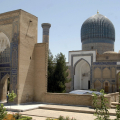GOUR EMIR
Like another great conqueror, Genghis Khan, Tamerlan wanted to be buried soberly: "Just one stone and my name on it," he said, and his tomb had been prepared in a crypt in Shahrisabz, his hometown. But history decided otherwise. In 1401, Muhamad Sultan, Tamerlan's favourite grandson and his appointed successor, built a four-minaret architectural complex consisting of an inner courtyard bordered by four iwans and overlooked by a madrasah to the east and a khanaka to the west. The madrasa was dedicated to the education of the sons of noble families destined to work in the administration. In the khanaka, residence of the dervishes, there was also a domed mosque. Today, only the traces of the foundations bear witness to these constructions, but one can admire the still richly decorated portal on which is inscribed in Persian: "Built by the weak slave Mohamed, son of Mahmud, of Espahan". When, in 1403, Muhamad Sultan, still young, perished during a campaign in Persia, Tamerlan had this mausoleum built, the most beautiful there is, for the one in whom he had seen his successor. When the first dome was completed, Tamerlan decided it was too small, had it destroyed and ordered a new, larger dome to be built, which was completed in less than two weeks. Ruy Gonzales de Clavijo recounts how the workers worked there day and night, and describes Tamerlan, sick and bedridden, coming twice in person to supervise the work. In February 1405, Tamerlan in turn died and his body, embalmed with musk and camphor, was temporarily and secretly buried in the khanaka next to his grandson. It was not until four years later, when the battles of succession were settled, that the royal remains returned to their present residence in the crypt of the mausoleum. On this occasion, Tamerlan's spiritual master, Sheikh Mir-Said-Bereke, was also buried. He was later joined by other Timurids, including two of Tamerlan's sons, Shakhrukh and Miranshakh, and his grandson Ulugh Begh. The latter added a gallery through which the mausoleum is now accessed and began the construction of another mausoleum, of which only ruins remain, and a crypt that can be seen behind the Gur Emir. It was also Ulugh Begh who brought back from Mongolia the block of nephrite that covers Tamerlan's tomb, and who had the mortuary slabs surrounded by an openwork marble barrier. The real tombs lie in the crypt. Like all the constructions of Tamerlan, the Gur Emir is grandiose. The volumes, simple, are of imposing size. The outer dome is 32 m high and a 3 m high Sufi inscription surrounds its base: it reads: "Allah is the only God and Muhammad is his prophet. "On this drum rests a stretched dome, 12.50 m high and 15 m in diameter, entirely covered with blue glazed bricks that sixty-four ribs dotted with yellow and midnight-blue rhombuses seem to stretch towards the sky. The interior of the mausoleum is even more sumptuous: firstly, the translucent green of the onyx walls, once decorated with gold and lazurite, then the blue and gold Qur'anic inscriptions that surround the room, and finally the dome, which the geometric gold decorations on a soft blue background make "like the firmament", in the words of the historian Cheref-ad-Din.
Did you know? This review was written by our professional authors.
Members' reviews on GOUR EMIR
The ratings and reviews below reflect the subjective opinions of members and not the opinion of The Little Witty.













